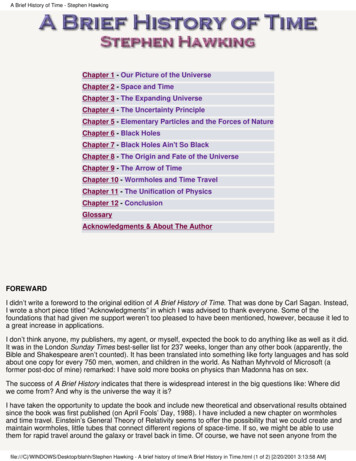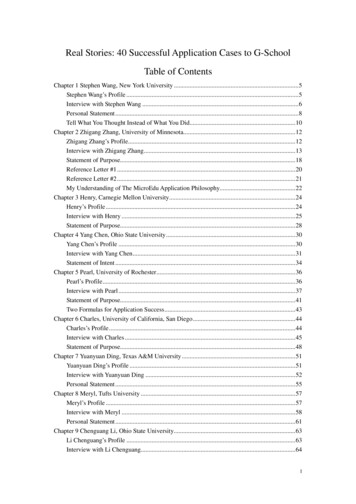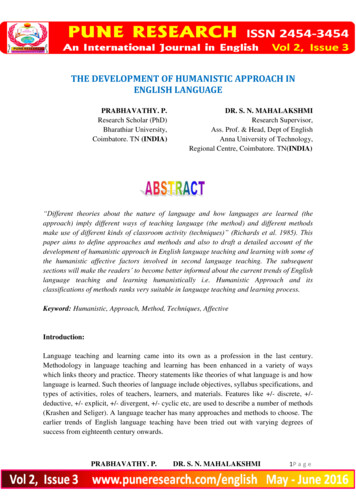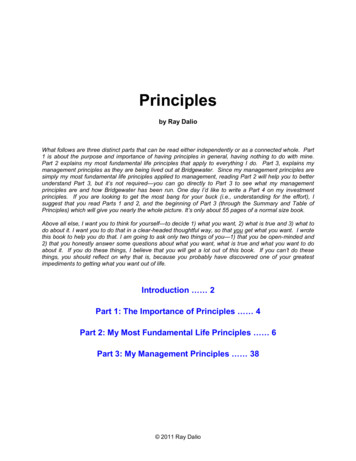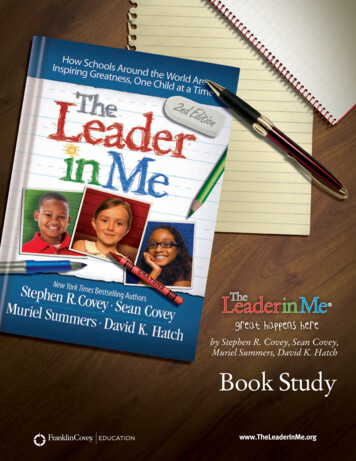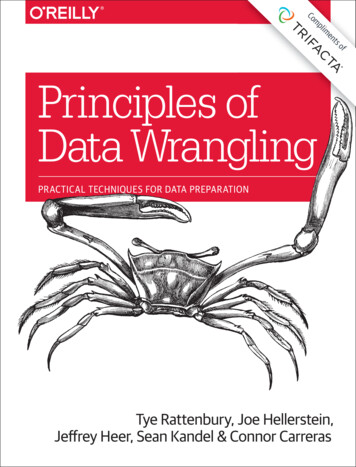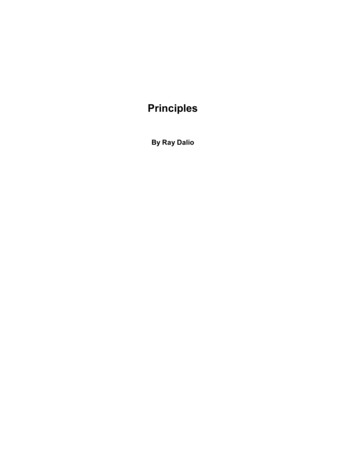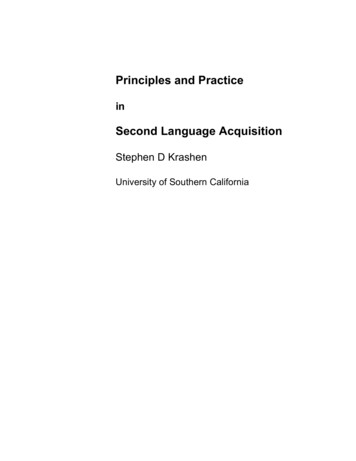
Transcription
Principles and PracticeinSecond Language AcquisitionStephen D KrashenUniversity of Southern California
This is the original version of Principles and Practice, as published in 1982, with only minorchanges. It is gratifying to point out that many of the predictions made in this book wereconfirmed by subsequent research, for example, the superiority of comprehensible-inputbased methods and sheltered subject matter teaching (Krashen, 2003), the inefficacy of errorcorrection (Truscott, 1996, 1999), and the "power of reading" (Krashen, 2004). Subsequentresearch has also, in my opinion, confirmed that in footnote 5, chapter 3, option 3 is thecorrect one, that we acquire vocabulary best through comprehensible input (Krashen, 1989;2003).I have changed my position on only one issue: At the end of Principles and Practice, I suggestthe use of a form of deception - students may think they are acquiring vocabulary or learningsubject matter, but unknown to them, they are acquiring because they are gettingcomprehensible input at the same time. I now think it is very important to make a strong effortto inform students about the process of language acquisition, so they can continue to improveon their own.Krashen, S. (1989) We acquire vocabulary and spelling by reading: Additional evidence forthe input hypothesis. Modern Language Journal 73, 440-464.Krashen, S. (2003) Explorations in Language Acquisition and Use: The Taipei Lectures.Portsmouth, NH: Heinemann.Krashen, S. (2004) The Power of Reading. Portsmouth, NH: Heinemann.Truscott, J. (1996). The case against grammar correction in L2 writing classes. LanguageLearning, 46 (2), 327-69.Truscott, J. (1999). What's wrong with oral grammar correction? The Canadian ModernLanguage Review, 55(4), 437-56.Introduction to the Internet Edition
Copyright 1982 Stephen KrashenAll Rights Reserved. This publication may be downloaded and copied without charge for allreasonable, non-commercial educational purposes, provided no alterations in the text aremade.First printed edition 1982 by Pergamon Press Inc.Print Edition ISBN 0-08-028628-3First internet edition July 2009i
AcknowledgmentsI am indebted to many people who have helped me both directly and indirectly. I can onlymention a few of them here. Earl Stevick and Robin Scarcella kindly provided me withdetailed comments on nearly every aspect of the manuscript. I have also received a greatdeal of useful feedback from John Schumann, John Oller, Adrian Palmer, Tracy Terrell,Andrew Cohen, Steven Sternfeld, and Batyia Elbaum. I am sure this book would be muchstronger if I had followed all their advice. The task of writing this volume was made mucheasier by the support and understanding of my family, my wife Eula, my children Deborah andDaniel, and my parents Leo and Julia Krashen. I would also like to thank my colleagues in theLinguistics Department at USC for their intellectual stimulation and encouragement. Iespecially thank Larry Hyman, Edward Finegan, Eugene Briere, Elaine Andersen, ElinorOchs, Edward Purcell, John Hawkins, and Bernard Comrie.ii
ContentsI. Introduction: The Relationship of Theory to PracticeA. Three Approaches to Method1. Theory of second language acquisition2. Applied linguistics research3. Ideas and intuitions from experienceB. Interactions Among Approaches to PracticeC. What the Three Approaches Have to Say About MethodD. Goals of This Book: to reintroduce teachers to theory andhopefully to gain their confidence againNotes12233467II. Second Language Acquisition TheoryA. Five Hypotheses About Second Language Acquisition1. The acquisition-learning distinction2. The natural order hypothesis(a) Transitional forms3. The Monitor hypothesis(a) Individual variation in Monitor use4. The input hypothesis(a) Statement of the hypothesis(b) Evidence supporting the hypothesis5. The Affective Filter hypothesisB. The Causative Variable in Second Language Acquisition1. The causative variables2. Language teaching: does it help?(a) When language teaching helps(b) When language teaching does not help3. Exposure variables4. Age5. III. Providing Input for AcquisitionA. The Potential of the Second Language ClassroomB. Limitations of the ClassroomC. The Role of Output1. "Conversation" and language acquisition2. Output and learning575859606161iii8
Contents cont.D. Characteristics of Optimal Input for Acquisition1. Optimal input is comprehensible(a) How to aid comprehension2. Optimal input is interesting and/or relevant3. Optimal input is not grammatically sequenced(a) The case against the grammatical syllabus4. Optimal input must be in sufficient quantity(a) Quantity requirements for initial readiness to speak(b) Quantity requirements for higher levels of proficiencyE. Other Features that Encourage Acquisition1. The student should not be put on the defensive2. Provide tools to help students obtain more inputF. "Teaching" Conversational Competence62636466687071717273737678IV. The Role of Grammar, or Putting Grammar in its PlaceA. Learning Does Not Become AcquisitionB. The Place of Grammar1. Grammar for Monitor use: when the Monitor is used2. What can be Monitored(a) Incompetent Monitor use(b) Rule learnability(c) Some evidence(d) Consequences of teaching "hard" rulesC. The Effects of Learning: Accuracy of Self-correction1. Factors affecting self-correction accuracy2. The dataD. Other Effects of Conscious RulesE. Presentation of Rules1. The deductive-inductive issue2. Sequencing and learningF. Notes on Error CorrectionG. Grammar as 3115116119V. Approaches to Language TeachingA. Present-day Teaching Methods1. Grammar-translation(a) Requirements for optimal input(b) Learning(c) Summary2. Audio-lingualism(a) Requirements for optimal input(b) Learning(c) Summary3. Cognitive-code(a) Requirements for optimal input(b) Learning125126127128129129129130132132132133134iv
Contents cont.(c) Summary4. The direct method(a) Requirements for optimal input(b) Learning(c) Summary5. The natural approach(a) Requirements for optimal input(b) Learning(c) Summary6. Total physical response(a) Requirements for optimal input(b) Learning(c) Summary7. Suggestopedia(a) Requirements for optimal input(b) Learning(c) SummaryB. Applied Linguistics Research1. Review of method comparison studies(a) American studies of AL, GT, and CC(b) The GUME project2. Some preliminary conclusions to method comparison studies3. More recent method comparison studies(a) The TPR series(b) Other input methods compared(c) Suggestopedia researchC. Alternative to Methods1. Function of the classroom2. The second language classroom and requirement #23. The alternatives(a) Conversation(b) Pleasure reading(c) Using subject matter for language teaching(d) Evidence for subject matter teaching: the immersion programs(e) Other possibilities in subject matter teachingD. Comments on Achievement Testing1. Normal considerations in test evaluation and selection2. Instructional value3. Language requirements4. University level ESLE. Some Gaps in Materials1. The language laboratory2. A comment on field testing of materialsF. Some hy191Index201v
Chapter IIntroduction: The Relationship of Theory to PracticeThe purpose of this book is to take a new look at an old question: the relationship betweensecond language teaching practice and what is known about the process of second languageacquisition. The usual way to do this is to discuss some research results first, outline apossible theory, and then list some implications. I will, to some extent, follow this plan. Asignificant portion of this book is, in fact, devoted to summarizing the current state of secondlanguage acquisition theory as I see it. Following this, I will draw some general conclusionsabout application to methods and materials, and eventually describe what characteristicseffective materials should have.Before going through this exercise, however, it is important to state in advance that"theory" and "theoretical research" should not be the only input into deciding on methodologyand materials. While my emphasis here is on theory and its implications, it is dangerous torely only on theory. There are at least three different ways of arriving at answers inmethodology and materials, and we must consider all of them. I will devote the remainder ofthis introduction to a brief description of these three areas, and a discussion of how theyinterrelate with each other. We will then see what each has to say about method in secondand foreign language teaching. My view, for those who like the punch line early, is that allthree ways arrive at precisely the same answer. The solution to our problems in languageteaching lies not in expensive equipment, exotic methods, sophisticated linguistic analyses, ornew laboratories, but in full utilization of what we already have, speakers of the languagesusing them for real communication. I will also conclude that the best methods might also bethe most pleasant, and that, strange as it seems, language acquisition occurs when languageis used for what it was designed for, communication.1
A. Three Approaches to Method1. THEORY OF SECOND LANGUAGE ACQUISITIONThe first area we will discuss will be the central focus of this volume, second languageacquisition theory. As developed today, second language acquisition theory can be viewed asa part of "theoretical linguistics", i.e. it can be studied and developed without regard topractical application. As is the case with any scientific theory, it consists of a set ofhypotheses, or generalizations, that are consistent with experimental data. These hypothesescan be arrived at using any of a variety of means (a brilliant insight, a dream, etc.). Theymust, however, be able to predict new data. In other words, hypotheses are not summaries orcategories for existing data and observations, but must pass the test of accounting for newdata. If our current hypotheses are able to predict new events, they survive. If they fail, evenonce, they must be altered. If these alterations cause fundamental changes in the originalgeneralizations, the hypotheses may have to be totally abandoned.Note that according to this way of doing science, we can never really prove anything!We can only look for "supporting evidence". When we do not find supporting evidence, orwhen we find counter-evidence, our hypothesis is in trouble. Even when we do find supportingevidence, when the hypothesis makes the correct prediction, a critic can always say that wehave not found "enough". Thus, a scientist, professionally speaking, is never able to state thatanything has been "proven". All the scientist can do is have a current hypothesis that he orshe is interested in testing.Later in this book I will present a series of hypotheses that make up a coherent theoryof second language acquisition. According to the rules of scientific method, it will always be"just theory" and never be "definitely proven". The hypotheses I will present have, however,been found to be consistent with a significant amount of data, experimental and otherwise,and have not yet been confronted with serious counterexamples, in my view. They make up,collectively, my "position". This does not mean that I necessarily "believe" them. What it doesmean is that these hypotheses are consistent enough with existing data to be worthy ofconsideration, and that they appear to capture the data better than other existinggeneralizations.2
Theory is abstract, and does not attempt to be practical. I hope to convince the reader,however, that in the case of second language teaching, there is nothing as practical as agood theory!2. APPLIED LINGUISTICS RESEARCHA great deal of research goes on in linguistics that is not aimed at supporting orattacking any coherent theory. This research, rather, is aimed at solving practical, realproblems that confront society. A few examples will hopefully make this category clear.An example that will be important to us in our discussion of language teaching consistsof experiments that compare teaching methods. Quite simply, a group of students is taught aforeign language using method A (e.g. audio-lingual), and another group is taught the samelanguage using method B (e.g. grammar-translation). The results of such an experimentwould certainly be of interest to theoreticians, since a particular theory might predict thatstudents studying using one method would do better than students using another. Theexperiment itself, however, is designed for practical ends, i.e. to decide which method weshould use in our schools.The research literature contains many applied linguistics experiments examining otherquestions of very practical relevance, e.g.:Will instruction in a second language make children more intelligent? (or lessintelligent?)Should non-English speaking children in American Bilingual Education begin to read intheir first language or in English?3. IDEAS AND INTUITIONS FROM EXPERIENCEA third approach to method does not rely on experimentation at all. It relies, rather, onthe insights and observations of experienced language teachers and students of foreignlanguages. It consists of "ideas that work" (the name of a column in the TESOL Newsletteredited by Darlene Larson, consisting of pedagogical techniques sent in by teachers),introspections by language students (e.g. "diary studies"), and other informal observations.While results of research are regularly presented in professional journals, teachers' insightsare not easily3
accessed and shared. Language teaching organizations often arrange meetings so thatexperienced teachers can share their techniques and insights with others (e.g. the highlysuccessful "mini-conferences" organized by the California TESOL organization). Empiricalsupport for new techniques is neither expected nor presented; rather, the word of the teacheris sufficient evidence, often, for a new idea to be at least tried out in different classes.B. Interactions Among Approaches to PracticeBefore discussing what each approach has to say about methods and materials, Iwould like to make a modest proposal: the three approaches should influence and help eachother. It seems obvious, first of all, that researchers would be interested in the results ofapplied research, since such experiments can provide potential confirming and counterevidence for theories of second language acquisition. Similarly, it stands to reason thatapplied linguistics researchers should pay some attention to strictly theoretical research, sincea successful theory might give researchers deeper insight into the results of their studies.It also seems reasonable to suggest that researchers in both theoretical and appliedlinguistics would benefit by both teaching and studying languages, in order to get more insightinto the language acquisition process. Similarly, one might expect practitioners to beinterested in the results of research, and one might also expect researchers to be veryinterested in the opinions of both teachers and language students.Figure 1.1 illustrates this ideal world, with information flowing between all three areasthat influence language teaching methodology. Figure 1.2 is, however, much closer to theactual state of affairs: there is, today, very little interaction between and among the threeareas.Fig 1.1. Ideal relationship between theory, applied linguistics research, ideas and intuitions andlanguage teaching practice.4
Fig. 1.2. Actual relationship between theory, applied linguistics research, ideas andintuitions and language teaching practice.In reality, many researchers are no longer involved in language teaching and languageacquisition, and do not interact with teachers. There is also far too little interaction betweentheoretical and applied research; those who search for the best method are often too littleconcerned with the underlying theory. What is perhaps most evident is that teachers andmaterials developers pay little attention to research and theorizing of any sort.There is good reason for this lack of interaction, especially the failure of researchersand teachers to interact. The reasons for this lack of communication do not stem from anyanti-intellectualism on the part of teachers. They stem, rather, from the failure of research tosupply relevant input in the past, combined with the insistence on the part of theoreticians thattheir insights were the only legitimate determinant of teacher behavior and materialsconstruction. In other words, we have, in the past, gone straight from theory to practice, and itsimply has not worked.Some well-known examples of this approach include the direct application of theprinciples of behaviorist psychology in the classroom, known as the audio-lingual method.Theoreticians insisted that dialogue and pattern drill were "the way" to teach language, andrecommended techniques that felt wrong to many teachers and students. A more recent"application of theory" was what may be called the "applied transformational grammar"movement, which featured materials directly based on current work in theoretical syntax andphonology. Applied TG did not significantly advance language teaching, for reasons that willbecome clear as we proceed. Its only tangible effect, perhaps, was that it needlessly mademany teachers feel unprepared because they had not been trained in the latest version oftransformational theory. (Lest the reader get the wrong impression, my personal view is thattransformational-generative grammar, and the5
progress it stimulated in formal linguistics, should be recognized as an extremely importantcontribution, and easily outdid previous theories of linguistic structure. My point here is that itdoes not necessarily follow that second language methods and materials should be baseddirectly on TG.)These two theories, then, failed. The first, behaviorist theory, failed to applysuccessfully to language teaching because it was, simply, not a theory of languageacquisition. The second, TG, failed because it was a theory of the product, the adult'scompetence, and not a theory of how the adult got that competence. It is not a theory of theprocess of language acquisition.The "new" theory, which I will present in Chapter II, is a theory of second languageacquisition, and attempts to deal with the process of language acquisition, not its product.Despite these virtues, it should only be considered one of several possible sources ofinformation in determining methods and materials for second language teaching.Compounding the failure of theoreticians to supply relevant theory has been the feelingamong practitioners that failure to make the theory "work" has been their fault. Theyincorrectly concluded that it was their ignorance of theory that caused these theory-basedmethods to fail. As a result of this, teachers in recent years have appealed mostly to area III,their own ideas and intuitions, in determining what they do in the classroom. What teachersactually do is no longer based on theoretical or applied research. Materials, and many bookson methodology, are based primarily on what seems to work in the classroom, and only rarelyon a theory (recall earlier books based on audiolingualism or TG), and are usually not fieldtested.C. What the Three Approaches Have to Say About MethodThe purpose of this book is to summarize one current theory and state the implicationsof the theory to method. I will briefly summarize here what some of these implications are,anticipating Chapter III. What current theory implies, quite simply, is that language acquisition,first or second, occurs only when comprehension of real messages occurs, and when theacquirer is not "on the defensive", to use Stevick's apt phrase. Language acquisition does notrequire extensive6
use of conscious grammatical rules, and does not require tedious drill. It does not occurovernight, however. Real language acquisition develops slowly, and speaking skills emergesignificantly later than listening skills, even when conditions are perfect. The best methods aretherefore those that supply "comprehensible input" in low anxiety situations, containingmessages that students really want to hear. These methods do not force early production inthe second language, but allow students to produce when they are "ready", recognizing thatimprovement comes from supplying communicative and comprehensible input, and not fromforcing and correcting production.In several places in this book I will attempt to make the point that research in appliedlinguistics is very consistent with the theoretical research in second language acquisition andits implications. The "best methods" according to comparative research studies (comparingmethods A and B, as described earlier) appear to be "input methods", those methods thatfocus on supplying comprehensible input in pressure-free situations.We can get an idea of what the "ideas and intuitions" area feels is the "best method" bya survey of pedagogically-oriented papers in current journals and the titles of presentations atteacher workshops. The titles have changed markedly over the years! A decade ago teacheroriented articles and presentations focused on grammatical description, reflecting the concernwith product, and procedures for drilling.1* Current titles more clearly reflect promoting realcommunication in the classroom, helping students understand spoken and written input andparticipate in conversations.2In workshops and mini-conferences, we no longer see presentations on fine points ofgrammar, or on types of substitution drill. "Ideas that work" are ideas about role-playing, usingthe newspaper as a teaching aid, socio-drama, etc. Moreover, newer methodology has, as aprimary goal, the lowering of student anxiety (see Chapter III).D. Goals of This BookThe primary goal of this book is to present current theory and its implications. There isanother goal, however, and that is to reintroduce*Superscript numbers refer to Notes at end of chapters.7
teachers to theory and hopefully to gain their confidence again. The time has come to look totheory again, realizing that the most current theory may still not be the final word on secondlanguage acquisition. I am not asking practitioners or materials developers to follow all of theimplications of theory blindly. My hope is only that our results will be considered as anothersource of ideas and input to methods and materials, in partnership with conclusions reachedby practitioners themselves from their own experience as language teachers and languageacquirers.Notes1Consider, for example, the table of contents of Language Learning, vol. 9, 1959, whichincluded:"Grammatical theory and practice in an English grammar class""Reaching the French verb";"Noun-classes and the practical teacher""Morpheme alternants in Spanish verb forms""'Thechnemes' and the rhythm of class activity"Volume 12, 1962, contained:"Annotated bibliography of generative grammar"2The 1979 volume of the TESOL Quarterly, for example, contains articles such as:"Using radio commercials as supplementary materials in ESL listening classes""Communicative writing""Joke-telling as a tool in ESL"reflecting the current emphasis on communication in the classroom.(Notes 1 and 2 certainly do not represent a wide sample of activity in the filed, but theyare representative. In recent years, the journal Language Learning has focussed ontheoretical and applied research, rather than pedagogy. For this reason, I used theTESOL Quarterly, which began publication in 1967, for current titles.)8
Chapter IISecond Language Acquisition TheoryThis chapter summarizes current second language acquisition theory. To do this, it firstdescribes some very important hypotheses. The first three, the acquisition-learningdistinction, the natural order hypotheses, and the Monitor hypothesis, are reviewed somewhatbriefly, as they have been dealt with a great deal in several other books and professionalpapers. Enough detail will be provided, however, to give the uninitiated reader a good idea ofthe hypotheses and the sort of evidence that exists to support them. The fourth hypothesis,the input hypothesis, may be the single most important concept in second languageacquisition theory today. It is important because it attempts to answer the crucial theoreticalquestion of how we acquire language. It is also important because it may hold the answer tomany of our everyday problems in second language instruction at all levels. Following thediscussion of the input hypothesis, we turn to the concept of the affective filter, a hypothesisas to how affective variables relate to the process of second language acquisition.The second portion of this chapter reviews a variety of factors that have been thoughtto be related to second language acquisition success, including instruction, differentmeasures of exposure to the second language, and the age of the acquirer. These factors, itwill be claimed, are not really causative factors. While they seem to relate to success orfailure to acquire second languages, the true causative variables in second languageacquisition derive from the input hypothesis and the affective filter--the amount ofcomprehensible input the acquirer receives and understands, and the strength of the affectivefilter, or the degree to which the acquirer is "open" to the input.9
A. Five Hypotheses About Second Language Acquisition1. THE ACQUISITION-LEARNING DISTINCTIONThe acquisition-learning distinction is perhaps the most fundamentalof all the hypotheses to be presented here. It states that adults havetwo distinct and independent ways of developing competence in asecond language.The first way is language acquisition, a process similar, if not identical,to the way children develop ability in their first language. Languageacquisition is a subconscious process; language acquirers are notusually aware of the fact that they are acquiring language, but are onlyaware of the fact that they are using the language for communication.The result of language acquisition, acquired competence, is also subconscious.We are generally not consciously aware of the rules of thelanguages we have acquired. Instead, we have a "feel" for correctness.Grammatical sentences "sound" right, or "feel" right, and errors feelwrong, even if we do not consciously know what rule was violated.Other ways of describing acquisition include implicit learning, informallearning, and natural learning. In non-technical language, acquisitionis "picking-up" a language.The second way to develop competence in a second language is bylanguage learning. We will use the term "learning" henceforth to referto conscious knowledge of a second language, knowing the rules, beingaware of them, and being able to talk about them. In non-technicalterms, learning is "knowing about" a language, known to most peopleas "grammar", or "rules". Some synonyms include formal knowledgeof a language, or explicit learning.1*Some second language theorists have assumed that children acquire,while adults can only learn. The acquisition-learning hypothesisclaims, however, that adults also acquire, that the ability to "pick-up"languages does not disappear at puberty. This does not mean thatadults will always be able to achieve native-like levels in a second language.It does mean that adults can access the same natural "languageacquisition device" that children use. As we shall see later, acquisitionis a very powerful process in the adult.* Superscript numbers refer to Notes at end of chapters.10
Error correction has little or no effect on subconscious acquisition, but is thought to beuseful for conscious learning. Error correction supposedly helps the learner to induce or"figure out" the right form of a rule. If, for example, a student of English as a second languagesays "I goes to school every day", and the teacher corrects him or her by repeating theutterance correctly, the learner is supposed to realize that the /s/ ending goes with the thirdperson and not the first person, and alter his or her conscious mental representation of therule. This appears reasonable, but it is not clear whether error correction has this impact inactual practice (Fanselow, 1977; Long, 1977).Evidence from child language acquisition confirms that error correction does notinfluence acquisition to any great extent. Brown and his colleagues have shown that parentsactually correct only a small portion of the child's language (occasional pronunciationproblems, certain verbs, and dirty words!). They conclude from their research that parentsattend far more to the truth value of what the child is saying rather than to the form. Forexample, Brown, Cazden, and Bellugi (1973) report that a sentence such as:Her curl my hair"was approved, because the mother was, in fact, curling Eve's hair" (p. 330). On the otherhand,Walt Disney comes on on Tuesdaywas corrected, despite its syntactic correctness, since Walt Disney actually came ontelevision on Wednesday. Brown et al. conclude that it seems to be "truth value rather thansyntactic well-formedness that chiefly governs explicit verbal reinforcement by parents--whichrenders mildly paradoxical the fact that the usual product of such a training schedule is anadult whose speech is highly grammatical but not notably truthful" (p. 330).The acquisition-learning distinction may not be unique to second language acquisition.We certainly "learn" small parts of our first language in school (e.g. for most people, the who/whom distinction), and similar distinctions have been made in other domains (see, forexample, Reber, 1976; Hall, 1959; and the review in d'Anglejan, 1978).11
2. THE NATURAL ORDER HYPOTHESISOne of the most exciting discoveries in language acquis
V. Approaches to Language Teaching 125 A. Present-day Teaching Methods 126 1. Grammar-translation 127 . second language teaching practice and what is known about the process of second language
